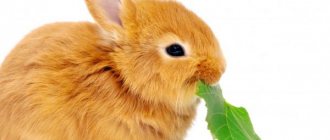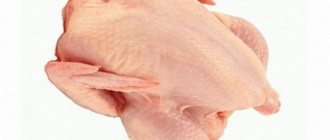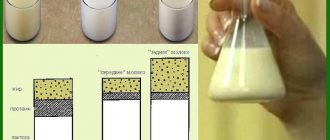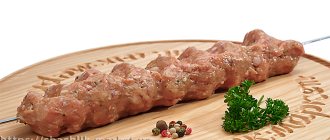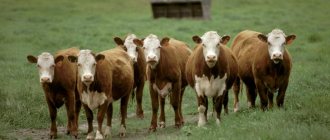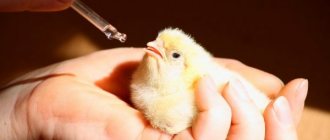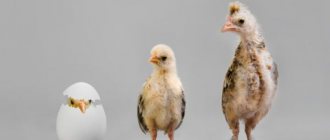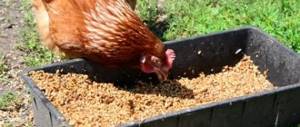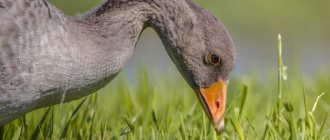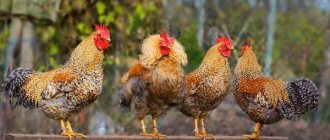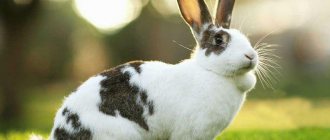External signs of a laying hen
Despite the fact that palpation allows you to more accurately identify a laying hen, farmers are often interested in how to find out whether a chicken is laying eggs or not, based on external signs. Indeed, in certain conditions, this option can be useful.
First of all, you should pay attention to the condition of the unfeathered part around the eye sockets, crest and earrings. If they are pale in color, look shrunken and tough, and feel colder to the touch than the rest of the bird’s body, then it is clearly not laying eggs.
In a laying hen, due to the rush of blood, the earrings and comb will be of increased size, bright scarlet in color, and soft and warm to the touch. It is also believed that a hen that is preparing to lay eggs or has just laid eggs tends to cluck loudly.
Another way to determine whether a chicken is laying eggs: a characteristic sign is the condition of the cloaca. Before inspection, the bird must be secured with its tail up between the knees. Carefully spreading the feathers around the cloaca, inspect its appearance. In a laying hen, it is quite wide and slightly swollen. It should also be moistened with a special secretion. In a bird that does not lay eggs, the opening is dry and compressed.
Determining age by activity
To find out how old a laying hen is and whether she will be of any use, it is recommended to know not only how to determine the age of laying hens by their comb, but also how to determine their lifespan by their activity. As mentioned above, old clumps are inactive. This is noticeable in their behavior. Usually they sit and calmly watch what is happening.
Many farmers know how to determine the age of laying hens based on their activity. Therefore, when purchasing the next batch, they leisurely watch the bird, assessing its activity. If during viewing it is clear that the hen is sluggish and slow, then this indicates that the bird is old.
( 1 rating, average 5 out of 5 )
What does egg production depend on?
The productivity of chickens depends on the following factors:
- from genetically determined egg production;
- from a balanced daily menu;
- compliance with the content rules.
To obtain enough egg products, it is necessary to breed the most productive egg breeds (or crosses):
- Leghorn;
- Rhodonite;
- Dominants;
- Russian white, etc.
Such hens lay 300 eggs or more in 365 days, but receive little meat from individuals of these breeds.
Many poultry farmers prefer to breed meat-egg chickens:
- Kuchinskaya;
- Adlerskaya;
- Amroks et al.
Such hens lay about 200 eggs in 365 days, but gain quite a decent weight in a fairly short period of time.
With a fully balanced diet, birds will lay eggs actively for several years. Compound feed for these birds should be purchased in stores - the factory feed is completely balanced, it includes all the components necessary for their development and productivity. But many poultry farmers prefer to prepare the mixtures themselves.
The daily menu should include: grains, green grass, vegetables, animal products - milk and fermented milk products, meat and fish products. Also, the daily menu should include a source of calcium - chalk and other substances so that the eggshell is strong.
To ensure that chickens do not reduce their productivity in winter, they must be kept in insulated, well-lit poultry houses. At the same time, the temperature in the chicken coop is maintained within 16-24 degrees Celsius. And the daylight hours in the chicken coop should be at least 13 hours, in this case the birds will not lay eggs worse in winter.
Tips for determining age
You can find out how to distinguish an old chicken from a young one by examining it externally, but none of the existing methods can give an absolute guarantee, so you should focus on several signs in combination. If the seller does not allow you to inspect the bird more closely, then most likely he is hiding the age of the hens he sells. This is what many sellers do who want to profit from inexperienced buyers.
The productive age of laying hens varies depending on their breed, but on average does not exceed 3 years, although hens can live up to 15 years. As a rule, after a decrease in egg production, the bird is sent to slaughter and replaced by the younger generation. When purchasing an adult, you should know that the error in determining age in external signs can be up to six months
The first thing you need to pay attention to is the behavior of the birds, which is always more active in young chickens. Old individuals are no longer in such a hurry to the feeder, have large bones, and look less graceful than pullets
Technological methods for determining the age of chickens
This group includes methods that make it possible to determine the age of a laying hen with a fairly high degree of reliability. Their common features include the need for some time spent monitoring egg production rates and determining the quality indicators of laid clutches.
Productivity Monitoring
This procedure involves daily palpating the exit of the oviduct for the presence of eggs. The operation must be performed in the morning for 1-2 weeks, while the egg production of good layers is 1 egg per week. With such indicators, it can be determined that the laying hen was born 5-6 months ago.
As the age of the pullet hen increases, the period of active egg-laying begins; at 6-7 months, the hen lays about 3 eggs per week. Maximum productivity rates of 5-6 eggs per week are typical for the age period lasting from 8-9 to 11-12 months.
Egg quality assessment
The beginning of laying in chickens of egg breeds can occur as early as 17 weeks, while in other breeds it occurs no earlier than 21 weeks. An auxiliary sign that allows you to determine the time of birth of a hen is the fact that after the normalization of the reproductive system, such hens lay eggs with a strong and thick shell.
At the same time, experts note that, despite the small weight of eggs (about 45 g), which distinguishes pullets from old hens, the nutritional value of such products is several times higher compared to clutches brought by adult birds.
Evaluating the appearance of the yolk
Assessing the size, color and consistency of the yellow substance inside the laid eggs also provides information about the time of birth of the chicken. However, when assessing the quality of clutches, it is necessary to pay attention to the diet of laying hens, since unscrupulous producers can add substances that enhance the pigmentation of both the hen’s body parts and the eggs she lays.
Important!
Eggs obtained from young individuals can be distinguished by the large size of the yolk, its rich color and thick consistency.
Experienced farmers recommend purchasing chickens in the spring, and their age should ideally be in the range of 4-6 months. In this case, the young age of the laying hen, nutritious feed in the spring and summer, and good living conditions will provide the breeder with maximum profit.
Gestation period
The number of eggs laid by chickens of different breeds differs. Egg hens begin producing eggs within five months of birth. The hybrid form develops a little longer and matures in a month or two. The daylight hours at the beginning of the egg-laying period should be about twelve hours. As soon as the chickens grow up and are more than nine months old, the daylight hours become longer and are increased to seventeen hours.
Sometimes hens begin to hatch eggs in a wide variety of places, which makes the process of collecting them difficult. To correct the situation, or to prevent it altogether, you can place an object resembling an egg in the nest. You can also take regular eggs, which are filled with a special mixture so that it does not burst due to the weight of the chicken.
Definition of laying hen
It must be borne in mind that even good laying hens have periods of “rest” when the chicken does not lay eggs. Upon completion, productivity is restored.
There are several ways to check whether a chicken is laying eggs or not:
Palpation. In the morning before the first feeding, each hen is visually inspected. Each chicken is picked up, the front part is fixed and the cloaca is lightly pressed with your fingers. Birds poop and lay eggs from a single opening called the cloaca. If the egg has formed, it can be felt. The distance between the pubic bones is also checked. A laying hen has 2 or more fingers between them. If this distance is less, the chicken does not lay eggs. Tags. Not the most convenient method, but the second most effective. Its essence is that you need to go into the chicken coop as often as possible and mark the chickens sitting on the nest with paint or ribbons. After a few weeks, chickens that did not lay eggs during this period will go without marks. Insulation. If you have free space or the opportunity to fence off a nook, you can place one chicken at a time for 2-3 days and see if it lays eggs
Please take into account that a sudden change of place may cause the bird to become stressed and stop laying eggs for this reason. It is better to fence off a corner in the chicken coop with a net so that the bird remains in a familiar room and can see its own kind. Condition of the cloaca
The chicken is fixed between the knees with its tail up, and the feathers around the cloaca are carefully spread apart. In a good laying hen, it is swollen, wide (the diameter of a five-ruble coin), and covered with wet secretion. A dry and compressed hole indicates that the hen is not laying eggs. Condition of the crest, wattles and unfeathered areas around the eyes. If they are bright scarlet from the rush of blood, enlarged, soft and warm, then the chicken is laying eggs. If they are pale, shrunken, hard and colder than the body of the bird, then they will not lay eggs. Clucking. If a chicken clucks loudly and shrilly, she has either just laid eggs or is preparing to do so. Full goiter. A non-standard option proposed by an experienced chicken breeder. According to his theory, with sufficient feeding, the hen eats at night only to have enough energy for the development of the egg. Accordingly, if you feel the crops of birds that have already settled on the roost, you can understand who will lay eggs the next day.
There is only one accurate way to identify a laying hen - palpation. All others are subject to error. However, they can also be useful in certain conditions.
How to find out the age of laying hens by their bellies
To implement this method, you will need to firmly hold the chicken in your hands and feel its belly.
Older individuals are distinguished by their rounded abdomen, which is hard to the touch. This indicates that the area around the abdomen is overgrown with fat and the muscle tissue is stiff. All these negative processes begin in the chicken’s body only after two years of age.
If a young chicken comes into your hands, its stomach reacts to pressure - it contracts under pressure.
During the manipulation, do not forget that there is a fragile egg inside the hen, which can be crushed if pressed hard. Therefore, movements should be as careful as possible.
According to the condition of the stomach. Another way to determine the age of laying hens is by palpation of the abdomen. In old laying hens, the rounded surface of the abdomen is very hard, since a sufficient amount of fat accumulates inside, and its muscles become stiff.
In the younger generation, when you press on the stomach, you can easily push it inward. But this procedure must be carried out carefully, since in chickens an egg with a thin shell passes through the oviduct, which is still fragile and can easily be crushed.
Determining the age of laying hens
In order to answer the question of how to determine the age of a chicken, you need to study the features of its appearance, which appear as the bird grows older. There are signs that are unique only to old hens, which serves as the main proof that the laying hen has already passed the peak of her productivity.
Mastering these techniques will help not only to cull old laying hens from young ones at slaughter, but will also allow you to make the right choice when purchasing an adult bird.
All methods by which it is possible to determine the age of chickens can be divided according to the external signs of the bird’s body:
- scallop condition;
- condition of the legs;
- beak condition;
- live weight;
- stomach condition.
- appearance of plumage.
Type of scallop
It is possible to determine the age by the comb with little accuracy, but you can immediately see which chicken has lost its productivity. Since the pigment that colors the shell and comb with lobes is common, its decrease in the body is noticeable by external signs.
So in young laying hens the comb is brighter and closer to red, while in older hens it gradually fades.
Determination by crest temperature is also possible. Since older birds have weaker blood circulation, they are cold. In young individuals, these parts of the body are always warm.
By the color of the comb, you can immediately notice a good laying hen, because bright coloring indicates the health and strength of the body, which allows us to claim long-term productivity.
In young chickens the comb is close to red
The next indicator of how to determine the age of a chicken is the condition of its legs. In pullets up to one year old, the color of the scales is yellow and uniform. Over the years, it turns into a grayer color, different shades from blue to red appear. The skin on the feet of older laying hens has cracks and abrasions, and the scales do not fit well in places.
Identification by legs is very effective and makes it easy to spot a bird older than 1 year. It is especially convenient when buying chickens at the market, because you can determine everything visually without even touching or taking them out of the cage.
This hen is no longer young. Cracks and abrasions on the legs tell us this.
Identifying a young laying hen by its beak is one of the simplest methods. The fact is that only individuals under one year old have a yellow beak and a smooth surface. With age, it begins to darken and becomes gray. Chips and scratches appear on its surface. It becomes matte and one gets the impression that a thin film is trying to peel off from it.
Therefore, by remembering what the beak of young birds looks like, you can very easily distinguish an old laying hen from a young one. When slaughtering, you should be guided by this parameter in order to cull from the mass chickens that are less productive and unpromising for breeding.
This hen's key is already turning grey. So she's over a year old
Other methods
You can estimate the age of a laying hen by daily palpating the oviduct for the presence of eggs in it. This procedure should be done in the morning for two weeks. In a healthy young individual, the frequency of oviposition will be on average 5-6 days.
Productivity will also directly depend on the age of the hen. By observing egg production, you can easily determine the moment the chicken hatches, but this is a long and not very convenient method.
You can tell how young a chicken is by the quality of its eggs. There are several proven ways to do this:
- The pullet egg is small, weighing no more than 45 g, but has a large yolk and contains a huge amount of nutrients. The older the chicken, the larger the egg (up to 75 g).
- The shell of an egg from a young bird is very difficult to break - it is strong and durable. In adults, the shell is fragile and small cracks often form on it.
- The yolk of the pullet is bright, colored a rich orange color. In older birds it is dull and pale yellow. Unscrupulous farmers sometimes add coloring pigments to the feed, which makes it impossible to determine the age of chickens by the color of the yolk.
- The yolk of an active hen is viscous and large, while that of an old hen is runny and small.
Sometimes, to understand how old a laying hen is, you need to know at what age the hen lays eggs. The fact is that young animals do not immediately understand the importance of this process. Closer to two years, the chicken sits on its own, and before that it needs help.
Description of the breed
The bird is distinguished by thick plumage, due to which it visually looks much larger than its actual mass. The color of the feather can be different: to date, 12 types of dominants have been bred, differing in their color.
The bird's eyes are orange and its earlobes are bright red. Chickens always have slightly smaller earrings than roosters. The scallop is scarlet, leaf-shaped and does not stand out for its large size, standing straight. The beak is yellow.
Dominants have a small head and small wings, a wide back. The tail is raised up. The legs are short and widely spaced, colored bright yellow or orange, making the bird look rather squat.
The most popular color varieties and their characteristic features:
- Brown dominant (D102). It has brown plumage, which is reflected in the color of the eggshell. Males most often have white plumage.
- Blue (D107). The most beautiful variety. The plumage is blue, the head is darker, almost black. The shell is brown. In this species, the sex of the chick can be easily determined by its appearance. Hens are born with dark plumage, and males are striped and have a characteristic white spot on their head. It is worth noting the rapid adaptation of the blue dominant to different climatic conditions.
- Partridge. Brown plumage shimmering in golden tones in the sun. The least egg-bearing subspecies, which performs more of a decorative function.
- Grey-speckled. Externally, the plumage resembles a cuckoo - black and white feathers alternate. High immunity, not afraid of cold.
- Red (D853). Somewhat similar to brown ones, but has a brighter and more saturated color.
- Red striped, or amber. A distinctive feature of the cross is the stripes on the feathers of a characteristic golden-red color.
- Sussex dominant (D104). Traditional white color with dark plumage on the tail and neck. The shell is light brown. Adapts perfectly to various conditions.
- Black. Uniform black coloring and bright red earrings and combs. It is distinguished by good health and the ability to adapt to sudden temperature changes.
The Czech dominant has a very gentle character. The bird does not get into fights and does not create conflicts. Easily and quickly gets used to a person and is not afraid of him. Reacts to human voice during feeding and walking.
The cross does not have a maternal instinct, so reproduction is possible only with the help of humans. There is an exception to this rule - the black dominant subspecies. These birds have partially preserved their maternal instinct: they can hatch eggs on their own and are attentive to their chicks.
The greatest egg production occurs upon reaching the age of one and a half years and lasts until two and a half, after which the indicators begin to fall.
You can buy dominants either in the form of eggs (for hatching yourself in an incubator) or as chicks. If you do not have sufficient skills, it is better to purchase an already strong bird. The minimum age of the chick is 7-10 days; it is better not to take younger ones. During this time, individuals gain enough strength to move.
Czech dominants are raised for eggs. The cross is distinguished by high egg production and taste. Puberty begins early, at the age of 4-5 months, and the hens are already beginning to lay their first eggs. At the same time, the weight gain of the bird itself persists for up to 11 months.
A special feature of the cross is that molting has virtually no effect on egg production. Laying hens continue to lay eggs, only slightly reducing their number.
Although the main purpose of breeding is to produce eggs, cross-breeds are also raised for meat. Chickens gain weight quite quickly and easily, and breeders note their excellent taste.
Young laying hens begin laying eggs at a certain age. How to find out exactly when pullets of laying hens begin to lay eggs, which can affect egg production - read the article. In addition, the influence of breed on productivity has been proven.
When does a healthy laying hen start laying eggs?
Normally, pullets of egg or meat-egg breeds begin to lay their first eggs at the age of 5-6 months. Leghorns are the record holders in this regard; they begin to lay eggs at 4.5 months.
See also
How many days or days does a hen need to hatch chicks, recommendations for egg selectionRead
The age at which eggs begin to lay is influenced by environmental conditions. If the chicken matures in the fall, and the poultry farmer does not place the bird in a warm barn with additional lighting in time, the bird will hatch later.
Poultry house preparation and housing conditions
One of the important conditions for keeping poultry, maintaining its health and obtaining high-quality meat and egg products from it is to provide it with good living conditions, that is, a high-quality and well-equipped chicken coop. Before moving the livestock, be sure to disinfect it. It should be spacious enough so that there is enough space for the entire population of chickens, and the chickens do not crowd each other.
The stocking density of chickens when kept on the floor is 5 individuals per 1 sq. m of poultry house area. When keeping birds in cages, no more than 5-7 birds are placed in one cage, provided that it is sufficiently free. You don’t have to keep roosters if you only need eggs for food, but if you plan to get your own chickens from them, then males are required in the flock. On average, 1 rooster is enough for 10 hens.
The chicken coop should be built from good material: durable boards (suitable for a summer chicken home) or bricks (for maintenance throughout the year). It is advisable to insulate it for the winter so that the chickens do not freeze in the winter cold and continue to lay eggs. To do this, the room temperature should not fall below 10°C. The chicken coop should be well lit, it should be dry, and it is advisable to equip it with a ventilation system.
The poultry house must have a sufficient number of perches and nests for laying hens (on average 1 per 3 individuals) so that they do not wait their turn and do not interfere with each other. In addition to nests, you will need a certain number of feeders and drinkers; there should also be no less than what is provided by the recommendations of experts. It is also necessary to take care of the bedding, especially when laying hens are kept on the floor. You can use fresh straw, clean sawdust, coarse sand.
It is necessary to provide the bird with the correct light regime and a complete and nutrient-balanced diet. If these conditions are met, the chickens will be healthy, grow quickly, gain weight well, but if for some reason they become ill, the poultry farmer must take all measures to treat them.
Egg production in chickens
The most important indicator of a laying hen is its egg production. It is calculated by the number of eggs laid by a chicken per year. Most poultry breeds produce about 200-300 eggs, with the maximum value approaching 400 eggs. The indicators of meat breeds are somewhat more modest: from one laying hen you should expect from 100 to 200 units of product.
Over the course of its entire life, the bird is capable of laying about 4 thousand eggs. With approximately this supply of eggs, she hatches into the world. The ability to reproduce in a chicken can last longer than 10 years, but already in the second year of life this indicator begins to gradually decrease.
In order for keeping poultry to justify the costs, it is necessary to monitor egg production, and the question: how to determine whether a chicken is laying eggs or not is relevant for farmers. Thus, in a poultry farm, egg breeds of chickens are kept for only 1 year, after which the livestock is completely replaced. In domestic areas, birds are replaced after 2-3 years of keeping.
What affects life expectancy?
Here we should immediately make a reservation that the main factor influencing how long a bird will live is the goal pursued by its breeder. So, it is he who decides how long a chicken or rooster will live - 3 years or 4 months. But there are a number of other factors that have a strong influence on the life expectancy of chickens and roosters in private farmsteads and factories.
Conditions of detention
In order for a bird not only to live a long time, but also to bring benefits to its owner, its living conditions must be as comfortable and favorable as possible all year round. This is why there are important factors to consider.
- Length of daylight. Chickens feel most comfortable when the daylight hours are 14 hours. Therefore, in the off-season and winter it is necessary to use additional lighting sources. Otherwise, the bird becomes lethargic, does not gain weight well, and its egg production is significantly reduced or stops altogether.
- Sufficient walking area. On average, one hen or rooster should have half a meter of free space. Otherwise, the birds will push each other and they will not have enough space for normal walking. In such situations, it is not uncommon for birds to die; they push, press on each other and eventually simply crush.
- The correct choice of the number of feeders and drinkers and their correct location in the chicken coop. Chickens must have free access to food and water, otherwise they will experience a lack of fluid and nutrients in the body.
- Correct temperature conditions. If the heat is too high, as well as extreme cold, the birds simply die, freeze or become lethargic. Rates of weight gain and egg production also decrease. Therefore, it is best if the temperature in the chicken coop is within 20-25 degrees above zero. In summer, the room should be well ventilated, and the walking area should be shaded.
- The chicken coop should be dry, there should be no places where liquid accumulates and there should be no constant dampness or mold. Otherwise, the bird gets sick, dies, and its offspring cannot be viable in the future.
Nutrition
An incorrect and unbalanced diet of birds often causes not only a decrease in their vital signs, but also early death. It is best to choose feed and mixtures designed specifically for a specific breed of bird, and, if necessary, additionally enrich it with fresh fruits, vegetables and grass. But before doing this, it is imperative to consult with a veterinarian or an experienced breeder. You can prepare formulas for feeding yourself, the main thing is to take into account what exactly they should contain in the correct proportions:
Increased egg production
Every farmer wants his courses to lay as many eggs as possible, so that this will provide them with the greatest profit. A solution to this problem has been found, and it consists in increasing the length of the day, using a variety of lights, lamps and other things. You can extend the day to about twenty-eight hours, which will give the bird the opportunity to lay eggs twice as long, because it is considered normal for an egg-layer to incubate eggs for about thirteen hours. Thus, farmers artificially enable the bird to lay another egg during the daylight hours. Despite all the benefits for the owner, the chickens suffer. By working so hard, they significantly reduce their life time.
An important component in ensuring that the chicken lays eggs well is compliance with the conditions of its keeping. If you properly maintain the thermal regime and provide fresh air, the chicken will be active and produce good laying. To understand whether the conditions correspond to the norm, whether the chicken feels good in the chicken coop, you can try its earrings, comb and earlobes; if all this is warm, then all the conditions are met, right. It is also important to feel these zones because they are the ones responsible for what kind of shell the egg will form, because it is not for nothing that there are eggs that cannot be broken at first, but there are those that crack from the slightest pressure.
To increase egg production, it is important for the farmer to be well aware of all possible methods in order to choose those that he considers most suitable, or try several to choose the most suitable for a given farm.
By creating the correct temperature regime for the chickens, the owner has the right to count on good results in laying eggs, and if he also organizes a place for the chickens to walk in the fresh air, then the number of eggs will be even greater. In addition, we should not forget that the nests where the birds spend most of their time should be as comfortable as possible, so that the chicken does not have to be distracted by fixing any problems with the seating area.
It is quite reasonable that healthy chickens will be able to produce more eggs of large size and without pathologies. It follows from this that it is important to feed chickens well, because it is food that strengthens the body and helps it cope with all the load that falls on the chicken. The food that should be fed to the bird must contain the necessary minerals and vitamins. The chicken's diet should be varied, it is not only dry food, but also greens that are added to it.
There is a period in a chicken's life when it does not lay eggs at all. This phenomenon is called molting. As soon as it ends, the chicken’s ability to hatch eggs is resumed.
Tips for poultry farmers
To obtain the maximum amount of egg production and stabilize indicators, private farm owners are advised to pay attention to the following factors:
Feeding livestock. It is very dangerous to underfeed and overfeed egg-laying chicken breeds. The bird should receive fresh and high-quality food, rich in vitamin and mineral complexes. Today, experts have developed special additives that significantly increase the productivity of egg products.
It is important to follow the instructions here. Maintaining temperature conditions. Chickens, and all other poultry, instantly react to such an important indicator, especially when it begins to change
If the temperature is too high or low, productivity will certainly decrease. With the onset of heat, it is necessary to ventilate the room, and in the winter months, if necessary, turn on additional heating sources. Lighting. As daylight hours decrease, the bird begins to lose its activity: it eats less food, reduces the number of movements - all this leads to fewer eggs being laid. To avoid this, it is necessary to maintain daylight hours between 12 and 14 hours. The first indicator is the minimum, the second is the maximum. Humidity indicators. It is best if the indoor humidity is kept at 60-70%. Number of livestock in the chicken coop. According to the standards, there should not be more than 4 birds per 1 square meter in a chicken coop. When kept in cages, this indicator will be completely different; it is important that poultry farmers comply with the developed standards. The same applies to arranging the premises with nesting houses, perches, and food containers. All this should be convenient for the chickens. Providing chickens with walks in winter. This is also a very important aspect that affects the amount of egg production. If weather conditions permit, the bird should be able to go out into the yard. Such a promenade will have a positive effect on the general condition of the chickens, and at the same time stimulate egg laying. Systematic veterinary examinations. A healthy bird lays eggs well, but if mites, feather eaters and other parasites appear that cause concern to birds, the amount of production will inevitably decrease or the process will stop altogether.
It is important to remember that laying hens' productivity decreases with age, and this does not depend on external factors. We invite you to join our Zen channel and group on VKontakte or Odnoklassniki, where new articles are published, as well as news for gardeners and livestock farmers
We invite you to join our Zen channel and group on VKontakte or Odnoklassniki, where new articles are published, as well as news for gardeners and livestock breeders.
- Important nuances when preparing a chicken coop for winter
- Problems in mass production of eggs and ways to solve them
- Diet for chickens with obesity
How to correctly determine the age of a laying hen?
Farmers who are just starting out in poultry farming often cannot correctly determine the age of chickens at the time of purchase. This is an important point, because its productivity depends on the age of the bird, and this is precisely why they are bought. Knowing just two factors: at what age chickens begin to lay eggs and the actual age of the pullets, you can start a profitable business.
You can tell a good laying hen by her behavior.
Every farmer should know that there are no exact parameters to determine the age of a chicken. There are only some recommendations, which we will discuss below. Inexperienced farmers often make mistakes when determining age, and it’s good if this mistake is for a month, and not for six months. Therefore, if you do not have confidence in your abilities, then it is better to go to the market to buy poultry with experienced people who can distinguish young laying hens from old chickens. If you have to make a choice yourself, use the following tips.
Chicken belly
Feel the belly of the hen; if she is old, her belly will be hard. This determines that the bird is already obese, and therefore does not guarantee high egg production. Remember that a laying hen will have the highest productivity in the first year, so we recommend that you refrain from purchasing chicken with a hard belly.
Crest
The bird is designed in such a way that the greater its productivity, that is, the more actively it rushes, the brighter its crest is colored. That is, a young laying hen’s comb should be bright red and warm to the touch, while an old hen’s comb should be light pink and cold.
Pay attention to the temperature of the scallop; it must be warm. In older individuals, blood circulation is impaired and therefore the comb becomes cold
A young laying hen should have a bright red comb and a yellow beak.
Beak and legs
Young chickens up to one year old are distinguished by the color of their beak. Their beak is a rich yellow color, while over time it begins to fade and in older chickens it takes on a gray tint.
It is also worth paying attention to the hen's legs. The feet of a young hen, which can lay eggs daily, will be smooth with even scales, while the feet of an old hen are already developing corns with cracks that can be distinguished by the naked eye
Activity
The older a chicken gets, the less active it begins to lead. If you throw food into a flock of birds, the young ones in the first rows will grab the best pieces of food, and older individuals will be content with what is left.
The older the chicken, the less active lifestyle it leads.
Weight
Weight is also an important factor in determining the age of a chicken. Young animals cannot weigh much. When purchasing grown chickens for a farm, you can determine their age by the time when the cockerels begin to crow. This usually occurs in the sixth month. There are many methods and folk ways of determining the age of a bird.
Just remember that even the most experienced farmer will not be able to give accurate advice on determining the age of a laying hen. But you don’t need to know this, since chickens are not kept on farms for more than two years, after which young ones are bought, and old ones are processed into stew. After a year, chickens begin to lay eggs less often, so keeping them becomes completely unprofitable.
Watch this video on YouTube
Age determination
It is not difficult to distinguish an old individual from a young one. You can resort to some methods, but you should understand that you will not be able to get an exact answer with their help. They indicate the approximate age of the hen. A more accurate answer can only be obtained from the seller.
Due to the fact that the maximum productivity of a laying hen occurs only in the first year of life, many farmers keep chickens for only a year. Then there is a replacement of old individuals with young ones.
Distinctive features of the abdomen
How to determine the age of chickens? In order to find out whether a laying hen is old or young, you should pay attention to the belly. If the adipose tissue feels hard to the touch, the individual is older
As chickens grow older, they begin to gain weight and become lazier. Accordingly, the subcutaneous fat layer increases.
The young laying hen is constantly active. This can be seen in the fact that she tries to get to the feeder first. But the old hen will stay on the sidelines, moving little.
If you want to buy a young laying hen, be sure to feel the chest and belly. If they are elastic and soft, the chicken will be able to bring a lot of benefits to the farm, since it has not reached the critical point of decline in such a parameter as egg production.
Comb and lobe color
A young specimen can be distinguished from an old one by the color of its comb and lobes. At an early age, these parts of the body are distinguished by a bright red hue. They will be warm to the touch. This is due to the fact that an active chicken has an excellent blood supply.
Chickens in years have a comb with lobes of a matte, dull shade. If you touch them, they will be cold. This is due to the fact that the blood supply is disrupted over time.
Weights
How to determine the age of chickens? You can distinguish a young laying hen by its weight. However, this technique is less truthful. Not only old hens can gain weight quickly, but also some young laying hens. If you do not have information regarding what indicator is typical for a particular breed, then making a choice based on this method will be problematic.
Beak and paws
The color of the beak can also tell a lot about the age of the birds, not just the comb and lobes. In young laying hens, this part of the body is brightly light. There is a slightly yellowish tint. Older individuals have a duller stratum corneum on their beaks. It is dominated by gray shades.
In order to distinguish a young laying hen from an old one, you can pay attention to the paws. If they have rough-looking growths or calluses of significant size, then the chicken is quite old
Young laying hens have clean feet that are free of scales and keratinized elements. In addition, their shade will be uniform.
It is recommended to pay attention to the soles of the paws. An old laying hen has quite a lot of deep cracks on them.
In young individuals they are several times smaller. And the skin looks much better on the paws.
Generally speaking, the skin on the paws is scaly. And in laying hens that are still capable of laying eggs quite well, the scales will fit tightly to each other. They will not be large in size. If you run your hand over the pullet’s leg, you shouldn’t see any rough spots.
Plumage
The age of a bird can be determined by looking closely at the plumage. If you know about the peculiarities of its change or about the annual molt, you can accurately indicate whether the chicken is capable of laying eggs well or not.
The pullet has a clean, smooth, dense and shiny feather. There should be fluff underneath. If you look at the wings, you can see two orders of flight feathers. At the edge there are long, fairly strong feathers with a wide fan. Then come the second order flywheels. The two rows are separated from each other by a dividing axillary wing.
Tail feathers can be seen in the tail area. There is tassel plumage around the coccyx.
It should also be noted that in chickens of the egg breed, feather renewal will occur until their age reaches 60 days. In beef breeds this may not occur until after 90 days. Typically, in chickens, complete replacement of primary feathers occurs by six months of age.
As practice shows, experienced poultry farmers are able to easily determine the age of a laying hen. Sometimes it’s enough for them to just look at a photo. And if you know such a person, you should listen to his advice when purchasing chickens. This, combined with the above methods, will help you make the right choice during your purchase.
